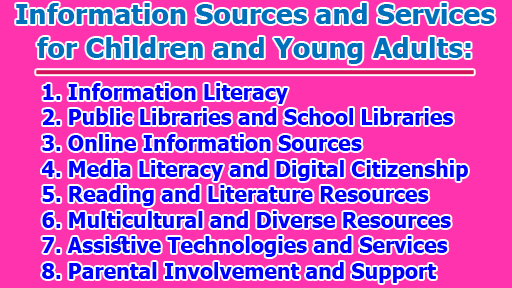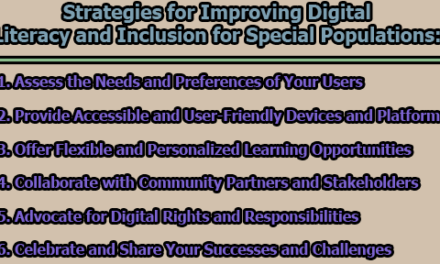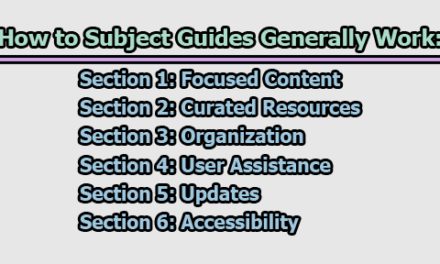Information Sources and Services for Children and Young Adults:
Information Sources and Services for Children and Young Adults play a crucial role in fostering their intellectual, emotional, and social development. Libraries, both public and school libraries, offer a range of resources, programs, and support to provide access to reliable information, promote reading and literacy, enhance digital skills, and encourage critical thinking. Online platforms, educational websites, databases, and diverse literature resources further contribute to empowering children and young adults to navigate the information landscape effectively. By nurturing information literacy skills, we equip the younger generation with the tools they need to succeed in an increasingly interconnected world.
1. Information Literacy for Children and Young Adults:
1.1 Definition of Information Literacy:
Information literacy refers to the ability to locate, evaluate, and effectively use information from various sources. For children and young adults, information literacy encompasses skills such as identifying reliable sources, understanding ethical use of information, critically evaluating information, and using information to solve problems and make informed decisions.
1.2 Importance of Information Literacy for Children and Young Adults:
In today’s information-driven society, information literacy is a crucial skillset for children and young adults. It empowers them to become critical thinkers, lifelong learners, and responsible digital citizens. Information literacy enables them to navigate the vast amount of information available and distinguish between accurate and unreliable sources.
1.3 Teaching Information Literacy Skills:
Educators and librarians play a significant role in teaching information literacy skills to children and young adults. They can incorporate information literacy instruction into the curriculum, guiding students on effective search strategies, source evaluation, citation practices, and ethical use of information. Hands-on activities, such as research projects and collaborative assignments, can enhance information literacy skills.
1.4 Integrating Information Literacy into the Curriculum:
Information literacy can be integrated across various subjects and grade levels, supporting students’ learning and research endeavors. By embedding information literacy instruction into the curriculum, educators can ensure that children and young adults have the necessary skills to access, evaluate, and apply information in different contexts.
2. Public Libraries and School Libraries:
2.1 Role of Libraries in Children’s Education:
Libraries, both public and school libraries, serve as vital information hubs for children and young adults. They provide a wide range of resources, services, and programs to support their educational, recreational, and personal development needs.
2.2 Public Libraries:
Public libraries offer numerous resources and services tailored specifically for children and young adults. These include dedicated children’s and teen sections, age-appropriate books and materials, storytimes, educational programs, homework help, digital resources, and access to technology. Public libraries also serve as safe and inclusive spaces for children to explore their interests and engage with their communities.
2.2.1 Services and Resources:
Public libraries offer a variety of services and resources, including:
- Age-appropriate books, magazines, and newspapers
- E-books and audiobooks
- Online databases and research tools
- Homework help and tutoring services
- Reading programs and book clubs
- Storytimes, puppet shows, and other interactive programs
- Maker spaces and STEAM (Science, Technology, Engineering, Arts, and Mathematics) activities
- Internet access and computer stations
2.2.2 Programs and Events:
Public libraries organize programs and events specifically designed for children and young adults. These can include author visits, workshops, summer reading programs, coding camps, cultural celebrations, and digital literacy initiatives. Such programs not only foster a love for reading and learning but also provide opportunities for social interaction and skill development.
2.3 School Libraries:
School libraries play a vital role in supporting the educational needs of children and young adults within the school environment. They provide access to educational resources, promote reading and literacy, and collaborate with teachers to integrate information literacy skills into the curriculum.
2.3.1 Collection Development:
School libraries curate collections of age-appropriate books, textbooks, reference materials, and digital resources that align with the curriculum and cater to the diverse interests and reading levels of students. Librarians collaborate with teachers and administrators to ensure the library collection meets the educational needs of the school community.
2.3.2 Collaboration with Teachers:
School librarians collaborate closely with teachers to integrate information literacy skills into classroom instruction. They co-plan and co-teach lessons, assist students in research projects, provide guidance on using library resources effectively, and support teachers in selecting appropriate materials for their lessons.
2.3.3 Digital Resources and Services:
In addition to physical resources, school libraries offer a wide range of digital resources and services, including online databases, e-books, multimedia materials, and educational software. These resources supplement classroom learning, provide access to up-to-date information, and support digital literacy skills development.
3. Online Information Sources for Children and Young Adults:
3.1 Websites for Children:
The internet offers a plethora of websites designed specifically for children, offering educational content, interactive activities, and entertainment. These websites can cater to various subjects, age groups, and learning styles.
3.1.1 Educational Websites:
Educational websites provide interactive and engaging activities that support learning across various subjects. They often include games, quizzes, videos, and interactive lessons, promoting active learning and knowledge retention. Popular educational websites for children include PBS Kids, National Geographic Kids, Funbrain, and ABCmouse.
3.1.2 Websites for Reading and Literature:
Websites focused on reading and literature encourage children and young adults to explore different genres, discover new authors, and engage with literary content. They offer book recommendations, author interviews, reading challenges, and online book clubs. Examples include Scholastic’s Book Wizard, Goodreads, Reading Rockets, and Bookopolis.
3.1.3 Interactive Learning Websites:
Interactive learning websites combine education and entertainment, providing a fun and engaging way for children and young adults to learn new skills and concepts. These websites offer interactive simulations, virtual labs, coding platforms, and creative tools. Notable examples include Code.org, Scratch, Khan Academy, and BrainPOP.
3.2 Online Databases and Research Tools:
Online databases and research tools provide children and young adults with access to reliable and authoritative information for their academic and personal research needs. These resources offer a vast range of topics, including encyclopedias, reference materials, scholarly articles, and multimedia content.
3.2.1 Encyclopedias and Reference Databases:
Online encyclopedias and reference databases, such as Britannica Online for Kids, World Book Student, and DKfindout!, provide age-appropriate information on a wide range of subjects. They offer reliable and concise articles, images, videos, and interactive features to support research and learning.
3.2.2 Digital Libraries and Archives:
Digital libraries and archives house a wealth of digitized resources, including historical documents, photographs, maps, manuscripts, and artwork. These resources enable children and young adults to explore primary sources, conduct historical research, and gain a deeper understanding of various topics. Examples of digital libraries and archives include the Digital Public Library of America (DPLA), the Smithsonian Learning Lab, and Europeana.
3.2.3 Research Databases:
Research databases provide access to scholarly journals, articles, and research papers across various disciplines. While these databases are often designed for a more advanced audience, some platforms offer specialized content and features for children and young adults. Notable research databases include JSTOR, ProQuest, and EBSCOhost.
4. Media Literacy and Digital Citizenship:
4.1 Understanding Media Literacy:
Media literacy involves the ability to analyze, evaluate, and critically understand media messages and their impact on society. For children and young adults, developing media literacy skills is crucial in navigating the vast array of media content and understanding its influence.
4.2 Promoting Digital Citizenship:
Digital citizenship refers to responsible and ethical behavior in the digital world. Children and young adults need to understand the rights and responsibilities associated with using digital technologies and engaging with online communities. Educators, librarians, and parents can promote digital citizenship by teaching online safety, responsible social media use, and respectful online communication.
4.3 Evaluating and Analyzing Media Content:
Teaching children and young adults how to evaluate and analyze media content is essential for developing critical thinking skills. They should learn to identify bias, misinformation, and persuasive techniques used in different media forms, such as advertisements, news articles, and social media posts.
4.4 Teaching Media Literacy Skills:
Educators and librarians can integrate media literacy instruction into the curriculum, guiding children and young adults in analyzing media messages, understanding media production techniques, and creating their own media content. By fostering media literacy skills, children and young adults can become discerning consumers and creators of media.
5. Reading and Literature Resources:
5.1 Importance of Reading for Children and Young Adults:
Reading plays a vital role in the intellectual, emotional, and social development of children and young adults. It expands their vocabulary, stimulates imagination, fosters empathy, and enhances cognitive abilities. Encouraging a love for reading from an early age sets a strong foundation for lifelong learning.
5.2 Recommended Reading Lists:
Recommended reading lists provide valuable guidance for selecting age-appropriate and high-quality books for children and young adults. These lists are curated by experts, librarians, and educators, taking into account various factors such as reading level, literary value, and diversity of perspectives. Examples of popular recommended reading lists include the Caldecott Medal Winners, Newbery Medal Winners, and Reading Rockets’ Best Books for Kids.
5.3 Book Awards and Literary Prizes:
Book awards and literary prizes celebrate outstanding books and authors, promoting the highest standards of literature for children and young adults. These awards recognize books that demonstrate literary excellence, creativity, and cultural significance. Prominent book awards include the Newbery Medal, Coretta Scott King Book Awards, Pura Belpré Award, and Michael L. Printz Award.
5.4 Reading Promotion Programs and Initiatives:
Reading promotion programs aim to foster a culture of reading and encourage children and young adults to engage with books. These programs can include initiatives such as book fairs, reading challenges, book clubs, author visits, and community reading events. Reading promotion programs can be organized by libraries, schools, and community organizations to engage children and young adults in literary activities.
6. Multicultural and Diverse Resources:
6.1 Importance of Multicultural and Diverse Resources:
Multicultural and diverse resources are crucial for children and young adults to develop an understanding and appreciation for different cultures, traditions, and perspectives. These resources promote inclusivity, empathy, and cultural competency, fostering a more inclusive and equitable society.
6.2 Culturally Relevant Books and Materials:
Culturally relevant books and materials reflect the experiences and identities of children and young adults from diverse backgrounds. They include books by authors from marginalized communities, books that explore diverse cultures, and books that challenge stereotypes and biases. Libraries and schools should actively curate and promote culturally relevant resources to ensure representation and foster inclusivity.
6.3 Online Resources for Multicultural Education:
Online resources, such as websites, databases, and digital platforms, provide access to multicultural and diverse content for children and young adults. These resources offer educational materials, interactive activities, and multimedia content that promote understanding and appreciation of diverse cultures. Examples include Teaching Tolerance, We Need Diverse Books, and the Smithsonian Learning Lab’s Global Cultures Collection.
6.4 Addressing Stereotypes and Bias in Children’s Literature:
Children’s literature has often perpetuated stereotypes and biases, reinforcing social inequalities. Educators, librarians, and parents should critically evaluate children’s books for biased content and actively seek out books that challenge stereotypes, promote inclusivity, and offer diverse perspectives. Engaging in conversations about stereotypes and bias can help children and young adults develop a critical lens and promote understanding and acceptance.
7. Assistive Technologies and Services:
7.1 Accessibility for Children and Young Adults:
Ensuring accessibility is essential for children and young adults with disabilities to access information and participate fully in educational and recreational activities. Assistive technologies and services help overcome barriers and provide inclusive experiences.
7.2 Assistive Technologies for Individuals with Disabilities:
Assistive technologies include tools, devices, and software that support individuals with disabilities in accessing information. These technologies can include screen readers, text-to-speech software, speech recognition software, tactile learning materials, and alternative input devices. By implementing assistive technologies, children and young adults with disabilities can access information and engage in learning activities independently.
7.3 Accessible Formats and Services:
Libraries and educational institutions provide accessible formats of books and materials for children and young adults with print disabilities. These formats can include braille books, large print books, audiobooks, and accessible e-books. Libraries may also offer services such as assistive technology training, specialized programming, and adapted materials to ensure inclusivity.
7.4 Inclusive Programming and Events:
Inclusive programming and events accommodate the diverse needs and abilities of children and young adults. This can involve providing sign language interpreters, captioning, sensory-friendly environments, and adaptive technologies during library programs, author visits, and other educational events. By implementing inclusive practices, libraries and educational institutions can create welcoming and accessible spaces for all.
8. Parental Involvement and Support:
8.1 The Role of Parents in Children’s Information Access:
Parents play a crucial role in supporting children’s information access and fostering information literacy skills. They can create a literacy-rich environment at home, engage in reading activities, and provide guidance on using technology and accessing reliable sources of information.
8.2 Encouraging Information Literacy at Home:
Parents can promote information literacy skills at home by encouraging critical thinking, asking questions, and engaging in discussions about the information children encounter. They can also guide children in evaluating sources, fact-checking information, and practicing responsible online behavior.
8.3 Collaborating with Libraries and Educators:
Parents can collaborate with libraries and educators to support their children’s information needs. They can communicate with librarians and teachers to understand available resources, participate in library programs and events, and contribute to the selection of age-appropriate materials. Collaborative efforts between parents, libraries, and educators enhance the information literacy support children receive.
8.4 Resources for Parents:
Numerous resources are available to support parents in promoting information literacy and accessing reliable information for their children. These resources can include books, websites, online guides, and workshops that provide guidance on age-appropriate materials, media literacy, digital citizenship, and information-seeking skills.
In conclusion, providing children and young adults with reliable information sources and services is crucial for their educational, personal, and social development. Libraries, both public and school libraries, play a central role in offering resources, programs, and support for children and young adults. Online information sources, media literacy instruction, reading and literature resources, multicultural and diverse resources, assistive technologies, and parental involvement all contribute to fostering information literacy and empowering children and young adults to navigate the complex information landscape of the 21st century. By ensuring access to quality information and developing critical thinking skills, we can equip the next generation with the tools they need to thrive in an information-driven world.
FAQs:
What are information sources and services for children and young adults?
Information sources and services for children and young adults refer to the various platforms, resources, and programs that provide access to reliable information, support literacy and reading, enhance digital skills, and promote critical thinking. These can include libraries (both public and school libraries), online databases, educational websites, diverse literature resources, and assistive technologies.
Why are information sources and services important for children and young adults?
Information sources and services are vital for children and young adults as they support their educational, personal, and social development. These resources help children and young adults access accurate and reliable information, develop literacy skills, foster a love for reading, promote digital literacy, and cultivate critical thinking abilities. By providing a wide range of resources and programs, information sources and services empower children and young adults to become informed and engaged citizens in today’s information-driven society.
What types of resources are available for children and young adults?
Various resources are available for children and young adults, including books, textbooks, reference materials, online databases, educational websites, interactive learning platforms, multimedia materials, and assistive technologies. These resources cater to different subjects, reading levels, and interests, promoting active learning, exploration, and skill development.
How do libraries support information needs for children and young adults?
Libraries, both public and school libraries, play a central role in supporting the information needs of children and young adults. They curate collections of age-appropriate books and resources, offer programs and events such as author visits and workshops, provide internet access and computer stations, and collaborate with educators to integrate information literacy skills into the curriculum. Libraries also offer digital resources, services for children with disabilities, and promote a love for reading and lifelong learning.
How can parents be involved in supporting children’s information needs?
Parents can play an active role in supporting their children’s information needs by creating a literacy-rich environment at home, engaging in reading activities, and guiding their children in using technology and accessing reliable sources of information. Parents can also collaborate with libraries and educators, participate in library programs and events, and utilize resources that provide guidance on age-appropriate materials, media literacy, digital citizenship, and information-seeking skills.
How do information sources and services promote media literacy?
Information sources and services promote media literacy by providing resources, programs, and guidance that help children and young adults analyze, evaluate, and critically understand media messages. They help individuals develop skills to identify bias, misinformation, and persuasive techniques used in different media forms such as advertisements, news articles, and social media posts. By fostering media literacy skills, information sources and services enable children and young adults to navigate the vast array of media content and become discerning consumers and creators of media.
How do information sources and services address diversity and inclusivity?
Information sources and services strive to address diversity and inclusivity by curating collections and resources that reflect the experiences and identities of children and young adults from diverse backgrounds. This includes offering culturally relevant books and materials, promoting diverse authors and perspectives, and challenging stereotypes and biases. Libraries and online platforms also provide resources and initiatives that foster cultural competency, inclusivity, and understanding among children and young adults.
How do assistive technologies support the information needs of children and young adults with disabilities?
Assistive technologies support the information needs of children and young adults with disabilities by providing tools, devices, and software that help overcome barriers to accessing information. These technologies include screen readers, text-to-speech software, speech recognition software, tactile learning materials, and alternative input devices. By implementing assistive technologies, children and young adults with disabilities can independently access information, participate in educational activities, and engage with the same resources as their peers.
References:
- American Library Association. (2018). Libraries Transforming Communities: Focus on Young Children and Their Families.
- American Library Association. (2021). Association for Library Service to Children.
- American Library Association. (2021). Young Adult Library Services Association.
- Coiro, J., Knobel, M., Lankshear, C., & Leu, D. J. (Eds.). (2014). Handbook of Research on New Literacies. Routledge.
- Elkins, A., & Hall, M. (2017). Library Services for Children and Young People: Challenges and Opportunities in the Digital Age. In Advances in Library Administration and Organization (Vol. 36, pp. 109-136). Emerald Publishing Limited.
- International Federation of Library Associations and Institutions (IFLA). (2015). IFLA Guidelines for Library Services to Children aged 0-18.
- Kumar, S. (Ed.). (2016). Library Services for Children and Young Adults: Challenges and Opportunities in the Digital Age. IGI Global.
- Lamb, A. (2011). Building Digital Libraries: A How-To-Do-It Manual for School and Public Libraries. Neal-Schuman Publishers.
- National Association for Media Literacy Education (NAMLE). (n.d.). Media Literacy Defined.
- Robbins, J., & Cahill, M. (2015). Everyday Librarian: How to Provide Library Services to Young Adults on the Autism Spectrum. Scarecrow Press.
- Schultz-Jones, B., & Wyman, L. (2013). Serving Teens and Young Adults in Libraries. Libraries Unlimited.
- Society for Research on Adolescence (SRA). (n.d.). SRA Statement on Youth Media Consumption and Media Literacy.
- Young Adult Library Services Association (YALSA). (2020). Teen Services Competencies for Library Staff.

Library Lecturer at Nurul Amin Degree College










